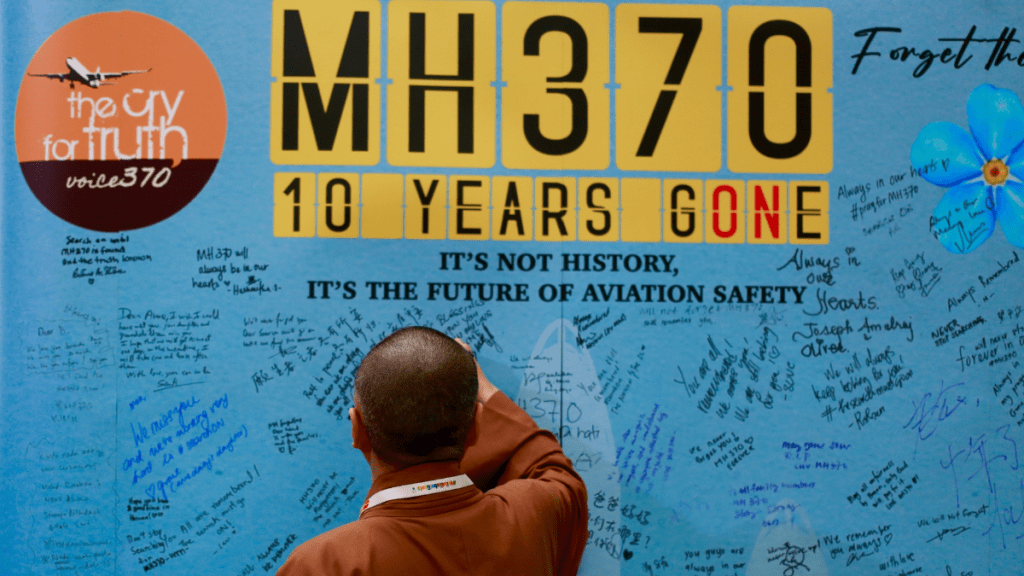The MH370 Flight disappeared on March 8, 2014, and it has been ten years since the mystery remains unsolved. The Malaysia Airlines flight departed from Kuala Lumpur en route to Beijing. The mystery behind the disappearance has led people to question what happened to more than two hundred passengers and crew members. Netflix’s documentary MH370: The Plane That Disappeared looks into the most puzzling case in aviation history.
As March 2024 marked a decade since the Malaysia Airlines MH370 disappearance, researchers may have an update. Reportedly, Cardiff University researchers may have identified the flight’s final signal shortly before disappearing in the Southern Indian Ocean. Researchers have made this discovery using a hydrophone (underwater microphone).
When did the MH370 flight disappear & How many people were onboard?
BBC stated that the MH370 Malaysia Airlines flight that disappeared over a decade ago had 239 people on board, including 227 passengers and 12 crew members. The aircraft departed from the Kuala Lumpur International Airport after midnight at 12:41 a.m. on March 8, 2014. The Beijing Capital International Airport expected the flight to land at 6:30 a.m. local time.
Kuala Lumpur’s air traffic controllers were the last to receive any communication from those onboard the plane. The pilots contacted them to inform them that the aircraft was making its way into another country’s airspace.
The director of Netflix’s MH370: The Plane That Disappeared, Alessandra Bonomolo, told a BBC podcast, “After 40 minutes, it disappeared from civilian radar.” She claimed the final conversation between the pilots and air traffic controllers was “entirely customary.”
Bonomolo added that pilots are required to do that when “they are going to move on to a different airspace – [which] in that case would have been the Vietnamese airspace. After this report, “The air traffic controllers in Malaysia know that they are no longer responsible for that plane because it entered another nation’s airspace.”
The outlet stated that the MH370 Flight vanished near Malaysian and Vietnamese airspace. The aircraft stopped communicating with air traffic controllers, thus triggering the great mystery. Subsequently, on March 17, the Australian Transportation Safety Bureau led the search for the missing aircraft. The search concluded after 1,046 days on July 17, 2018.
According to CBS News, sometime in July 2015, a flaperon from the MH370 Flight washed ashore on the western Indian Ocean island of Reunion. This plane fragment proved to be the first evidence confirming that the missing aircraft had indeed gone down. Over the years, more debris from the flight has washed ashore on the coast of eastern Africa.
Several theories have surfaced concerning the disappearance of the MH370 Malaysia Airlines flight. Some believe that Captain Zaharie Ahmad Shah, then 53, likely crashed the aircraft in a mass murder-suicide. Other theories also suggest a case of mechanical failure or hijacking. Reportedly, authorities had investigated several passengers on the claims of highjacking and found that two individuals were using fake passports. However, there was no evidence to link those onboard to the flight’s disappearance.
In a recent update, efforts from researchers have raised a slight chance that the MH370 mystery can be solved. The Independent reported that Cape Leeuwin possibly recorded a weak six-second signal, which was the last emitted by the MH370 Flight. Additionally, the researchers claim that if the flight crashed at a speed of 200 meters a second, it would have released enough kinetic energy to resemble a small earthquake.
Cardiff University’s School of Mathematics reader Dr. Usama Kadri claimed that “official investigations concluded the aircraft must have crashed near the 7th arc.” This was the final communication that the MH370 pilots made the point with INMARSAT [the satellite telecommunications company].
The researchers have urged authorities to conduct field experiments, including “controlled explosions or airguns along the 7th arc.” This can help them monitor the impact on signals received at nearby hydroacoustic stations. One such hydroacoustic station is Diego Garcia in the Indian Ocean, which was operating when the flight vanished.
Additionally, Dr. Usama Kadri said that they have failed “to find a signal with the certainty needed to launch a new search for the missing aircraft. She added that they “can assess the relevance of the observed signals” with the assistance of “appropriate authorities.” This can help them in “potentially shedding light on the location of MH370.”
MH370: The Plane That Disappeared documentary is now streaming on Netflix.










